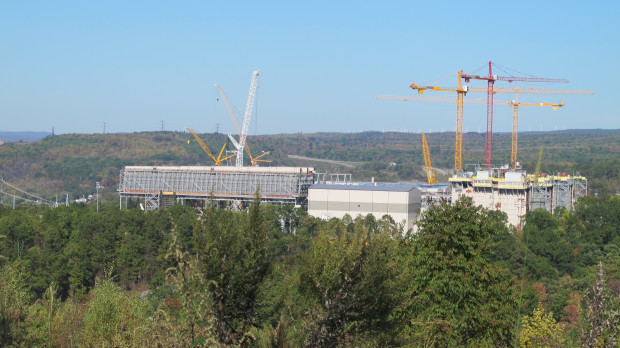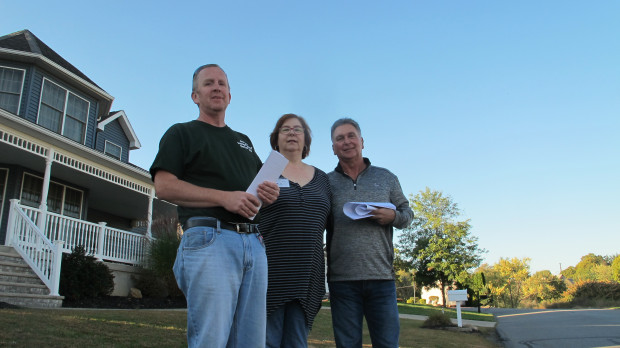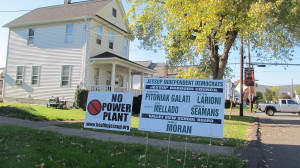Big power plant ignites political fight in small Pennsylvania town
A wave of new gas-fired power plants is hitting the nation, with uncertain implications for the climate. The local consequences can be just as thorny.

Marie Cusick / StateImpact Pennsylvania
At 1,485 megawatts the Lackawanna Energy Center is one of the largest natural gas power plants in the works nationwide.
JESSUP—The biggest new natural-gas power plant in a state awash with them is taking shape on a mountain ridge overlooking the community it cleaved apart.
First came questions about pollution and property values. Lawyers and public-records requests followed. Now this borough of 4,500, where it’s only a slight exaggeration to say that everybody knows everybody, is embroiled in a full-out political revolt.
Pro-plant incumbents up for election this year — two council members and the mayor — were booted in the May primary. A ticket organized by plant opponents boasts five people on the ballot in next week’s general election — candidates for all the open council seats and even school board director, which shows just how far the fault lines over the Lackawanna Energy Center extend. Relationships have been upended. Mistrust in local government has surged.
“It’s like a raw nerve,” said Ellen Nielsen, president of the school board.
Pennsylvania has long been a power-plant colossus, exporting electricity to other states because it makes more than it uses — historically with coal and nuclear. The Jessup plant is at the vanguard of a new boom fueled by the state’s plentiful natural gas.
Only Texas has more planned gas-fired generation in the queue, according to U.S. Energy Information Administration data. Energy firms have proposed over 40 gas-fired projects in Pennsylvania since 2011, including in Jessup’s neighbor Archbald. Fourteen are under construction or operating. At 1,485 megawatts, Jessup’s Lackawanna Energy Center is one of the largest in the works nationwide, according to EIA data — part of a dramatic coast-to-coast expansion of gas-fired plants.
Developers have proposed more than 40 gas-fired power plants in Pennsylvania since 2011, spread around the state. Red icons on the map represent small projects using internal combustion engines. The plant-shaped orange icons represent larger, combined-cycle turbine projects. (Map by WITF’s Tom Downing.)
Map tiles by Stamen Design, under CC BY 3.0.
Electricity needs aren’t driving this upturn. Instead, in this part of the country, it’s developers hoping cheap gas will fuel profitable power plants in an increasingly crowded market. In the large, interstate electrical grid that includes Pennsylvania, the gas-plant rush is so huge it’s “poised to create a glut of supply” amid “little prospect of growth in demand,” credit-rating agency Moody’s Investors Service warned in May.
Customers will likely benefit from lower electricity bills, at least for a while. People who live near coal plants that close in the face of this stiff competition will breathe healthier air. But the rapid reshaping of U.S. electric power comes with some unpredictable, long-lasting implications.
Consider global warming. Natural gas produces roughly half the greenhouse gases as coal when burned, but it also leaks into the atmosphere as the potent warming agent methane when drilled, transported and consumed. Because the full extent of these leaks isn’t known, scientists can’t say just how much better for the climate gas is than the coal it’s replacing — and some fear it’s worse. Newly built gas plants are also displacing zero-carbon nuclear plants, competing with renewable-energy sources and locking in decades more fossil-fuel use at a time when nearly all the world’s countries agree that climate-warming emissions must be sharply cut.
To meet the goals set in Paris last year, aimed at avoiding the worst consequences of climate change, “no new investment in fossil electricity infrastructure (without carbon capture) is feasible from 2017 at the latest,” University of Oxford academics concluded in a study last year.
For the Pennsylvania towns considering plants — tiny municipalities outmatched by the well-resourced companies approaching them — there are other considerations that can seem daunting as well, from zoning to wastewater.
“Decisions made today cast long shadows,” said Gerald Cross with the Pennsylvania Economy League, a think tank.
Jessup is a cautionary tale for elected officials and citizens alike. Those who mobilized against the plant — which will begin operation next year — couldn’t stop it, couldn’t get it decreased in size, couldn’t convince their borough to bring in an expert to negotiate the project’s financial terms. They don’t regret the time and money they’ve spent — they’ve had some wins, the primary election among them. But those amount to a muted triumph after all the losses.
The power plant and the citizens group
Chicago-based Invenergy is a major developer of renewables, particularly wind power. Pennsylvania is a state with a lot of untapped wind potential. When Invenergy went scouting for locations in northeastern Pennsylvania, though, it was a different resource that appealed. Gas flows fast from Pennsylvania’s share of the Marcellus shale play, unlocked by hydraulic fracturing, or fracking.
The company, which holds about a third of its portfolio in gas, wanted a big plant that would be so efficient it could win out in the competition to provide electricity. Invenergy sees gas as a key part of a “clean energy” future, said Dan Ewan, the company’s vice president of thermal development.
In Jessup, less than 10 miles northeast of Scranton, the company had easy access to what it needed: Not just gas, but also workers, transmission lines, even train tracks to move equipment in.
“The project provided us with a lot of the things that make a power plant a good investment,” Ewan said.
In 2015, as the public heard about Invenergy’s plans, the company said the plant would be good for the community, too. Some in Jessup, and unions in the broader region, emphatically agreed. They pointed to the jobs for hundreds of construction workers — many of whom were struggling after a long building drought triggered by the housing bust — and the money for local businesses that could benefit from the activity.
But once construction ended and the 30-employee plant fired up, it would pump out pollution for the four or more decades of its expected life. The prospect that it could displace more-toxic coal plants didn’t seem a fair trade to some residents, with the nearest coal-fired sites more than 40 miles distant and tiny. And they were upset to learn that their local officials OK’d waiving taxes on the Moosic Mountain property through 2023 to encourage development — after Invenergy had already decided to build on it.
These people banded together, a few, then dozens — a retired accountant, a nurse practitioner, a winery owner, a business manager and a former Jessup councilman, among others.
Calling themselves Citizens for a Healthy Jessup, they first tried to convince their borough council not to amend zoning to allow the development on the proposed site, which sits half a mile from homes. Invenergy told the council that Jessup was in violation of state law because a power plant could not feasibly be built anywhere in the community, even in the part of Jessup with zoning that permitted it. The residents presented a case that the company could in fact construct a plant elsewhere in Jessup — a smaller one.

Marie Cusick / StateImpact Pennsylvania
The split in Jessup touched off by the power plant sliced through the local Democratic party. Five people, including school board candidate James Moran (left) and borough council candidates Roberta Galati (center) and Peter Larioni (right), are running as Jessup Independent Democrats. The two incumbent council members running as mainline Democrats lost in the May primary election.
They hired a lawyer, pored over arcane regulations, went to each council meeting and sent a mailer to everyone in the borough. Jessup’s planning commission agreed that the zoning should remain unchanged, but the council had the final say.
And the council voted in Invenergy’s favor in 2015 — first to alter the zoning, later to allow the plant at full size. That followed a “build the plant” public-relations campaign by Invenergy and its supporters that included an opinion piece from former Pennsylvania Gov. Ed Rendell, who’d received tens of thousands of dollars in campaign contributions from the politically connected developer selling the land to Invenergy.
Council members said the plant’s economic benefits, in their estimation, outweighed any disadvantages.
“I just personally felt that it was a boon for this area,” said Maggie Alunni, a Jessup councilwoman now finishing the last of her 16 years on that body after being voted out in the primary. “I honestly believe this is going to bring more industry and more prosperity to our area than if we had turned it away.”
Most people in a one-sided fight probably would have given up at that point. But “it was such a large, life-changing impact,” said Thomas J. Fiorelli III, a Citizens for a Healthy Jessup leader who served as a councilman from 2001 to 2006. So, as the focus shifted from whether the plant should be built to how much money the community would receive from it, the residents regrouped. They wanted Jessup to get as much as it could.
This time, they thought, they and their council surely would see eye-to-eye.
The deal on the table
Unlike most states, Pennsylvania doesn’t allow local governments to tax most of the overall value of power plants, according to Mark Pomykacz of Federal Appraisal, a consulting firm in New Jersey. That means less of a budget boost for communities absorbing projects, even when officials don’t temporarily waive the taxes, as Jessup did.
Amid mounting opposition, Invenergy said it would make extra, non-tax payments to the community until the power plant closed. The company offered $500,000 a year as a “host agreement,” then upped it to $1 million a year with additional upfront money.
A law firm for the citizens’ group recommended that the borough ask for much more, pointing to communities outside Pennsylvania that struck deals with higher payments per megawatt. Instead, the council’s negotiator and another borough staffer spent nearly an hour at a public meeting in 2016 arguing that Invenergy’s offer was excellent and the citizens’ lawyers didn’t know what they were talking about.
Jason Petrochko, president of Citizens for a Healthy Jessup, watched the meeting unfold, stunned.
“That was when I really began to feel like something wasn’t right,” he said. “When they argued against trying to get more money, they were doing the job Invenergy should have done.”
When it was Petrochko’s turn to speak, he reminded the council that no one in the room had expertise in host-agreement negotiations except Invenergy’s lawyer — not even Jessup’s negotiator, a lawyer who serves as the borough’s solicitor. Petrochko, touching on school funding woes and other local needs, said Jessup needed to hire an expert to make sure it got the best deal.
Four days later, the council voted 5-1 to accept the agreement as it was.

Marie Cusick / StateImpact Pennsylvania
"We lost a lot of sleep over this," says Jessup solicitor Richard Fanucci, "making sure we did the right thing."
Richard A. Fanucci, Jessup’s solicitor, stands by the deal he negotiated. Like Invenergy, he said it’s by far the best of the few power-plant host agreements in Pennsylvania, which does not require them. He saw no need for an outside lawyer to handle the negotiations because he has long experience with municipal, zoning and contract law in the region.
“We lost a lot of sleep over this, making sure we did the right thing,” he said. He pointed to other power-plant communities in Pennsylvania that “got zero, they have nothing. In fact, we received calls from representatives in those municipalities, saying, ‘How the heck did you guys do that?’”
But as substantial as the payments will be for a borough with a $2.2 million annual budget, the organized citizens weren’t the only ones who thought more was possible. The council, the Scranton Times-Tribune’s columnist wrote after the decision, “squandered a rare opportunity for a small community to negotiate with a big corporation from a position of strength.”
Jessup at least got more money than Invenergy originally said it was willing to pay. The tri-borough Valley View school district, which has had to shutter its aging pool at least temporarily and raise taxes to cover budget gaps, actually ended up with less after Jessup finished negotiating.
The schools will receive a guaranteed $500,000, spread over five years. But they would have had about $2 million over the life of the plant under Invenergy’s original proposal, which earmarked 10 percent for the district. Had the final deal included such an earmark, the district would be getting roughly $5 million.
That was sobering news to Nielsen, the school board president. She’d thought the matter had worked out in the schools’ benefit.
“I guess I should have been aware of it, but I wasn’t, because the plant was built in Jessup and I wasn’t that much involved,” said Nielsen, a resident of neighboring Archbald.
Fanucci said the results were fair because the school district wasn’t a party to the zoning matter. It had no right to money beyond what Jessup chose to set aside for it, he said.
The school district’s lawyer might have argued otherwise — if that lawyer weren’t Fanucci himself. He’s represented both the schools and the borough for years.
Nielsen now thinks that the school board, “knowing what happened with Jessup,” might want to get a negotiator for a host agreement involving Archbald’s smaller proposed power plant. Archbald Councilwoman Erin Owen, whose husband is a school board member, strongly recommends that.
Owen already convinced her council to hire its own specialist for the negotiations. The Jessup host agreement was a raw deal, in her opinion, and the process left a sour taste in people’s mouths.
“A lot of long-time friendships were lost,” she said.
Figuring out a way forward
Shattered relationships are no small matter in a community that resembles an extended family. Many here have lived in Jessup their whole lives, or close to it, and they’re suffering through what amounts to a bloodless civil war.

Marie Cusick / StateImpact Pennsylvania
A ticket organized by plant opponents boasts five people on the ballot in next week’s general election.
People with concerns about the Lackawanna Energy Center speak with emotion about how their faith in people they grew up with was ruined. Some who strongly supported the project — such as Ginger Adams, whose Jessup café has seen sales rise since construction began — discovered that friends had come down passionately on the other side of the argument. The plant was a key reason Petrochko’s family moved out of Jessup to a nearby town this year, while Fanucci, whose family has lived in the Jessup area for generations, isn’t sure he wants to continue as the borough’s solicitor. And the president of the council recently tendered his resignation.
“I just want Jessup to heal,” said Alunni, the outgoing Jessup councilwoman. “I want it to go back to the way it was.”
That’s not to say she wishes the plant hadn’t been built. She still thinks going forward was the right decision. There’s the money the borough will get, which she believes was well-negotiated. And more than 1,000 construction jobs — a “godsend” that has pushed a high jobless rate among the region’s construction workers to basically zero, said Pat Dolan, president of the Scranton Building Trades Council.
Depending on how the general election goes, candidates affiliated with Citizens for a Healthy Jessup could gain a majority on the seven-seat council. It’s too late to stop the plant or get a vote on the host agreement, of course. But Roberta Galati, whose successful run in the Democratic primary was her first bid for public office, said there’s still important work to be done.
“We want transparency,” said Galati, a retired bank manager who would earn about $2,000 a year if elected. “I can’t believe … how blindly I let them do whatever they wanted to do. Years ago, I should have been going to these meetings. But better late than never, I guess.”
The residents think they’ve had an effect on the plant, despite the disappointments. If no one had organized against the project, they wonder, would there be a host agreement at all? If they hadn’t tested the stream into which Invenergy planned to discharge wastewater so there would be a record of pre-plant conditions, would the company still have decided to ask to use the sewer system instead?
In September, as a band played classic rock and people ate kielbasa sandwiches the citizens’ group was selling to raise money for air testing, Joanne Kilgour with the Pennsylvania chapter of the Sierra Club considered the bigger picture beyond the power plant. Residents’ suggestions and requests were dismissed, she said, but they kept coming to meetings and asking questions. She sees in it a reminder for all Americans: “Our democracy is something that isn’t just handed to us, but that we have to be an active participant in.”
The late afternoon sun shone on the fundraiser in the valley and the power plant up on the mountain, and the music played on.
Marie Cusick of StateImpact Pennsylvania contributed to this story.
















